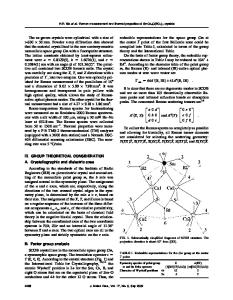Growth and Spectroscopic and Magnetic Properties of TbCr 3 (BO 3 ) 4 Crystals
- PDF / 1,443,005 Bytes
- 8 Pages / 612 x 792 pts (letter) Page_size
- 104 Downloads / 318 Views
th and Spectroscopic and Magnetic Properties of TbCr3(BO3)4 Crystals N. N. Kuzmina, b, c, *, V. V. Maltseva, E. A. Volkovaa, N. I. Leonyuka, K. N. Boldyrevb, c, and A. N. Bludovd aMoscow
State University, Moscow, 119991 Russia Institute of Spectroscopy, Russian Academy of Sciences, Fizicheskaya ul. 5, Troitsk, Moscow, 108840 Russia c Moscow Institute of Physics and Technology (National Research University), Institutskii per. 9, Dolgoprudnyi, Moscow oblast, 141701 Russia d Verkin Institute for Low-Temperature Physics and Engineering, National Academy of Sciences of Ukraine, pr. Nauky 60, Kharkiv, 61103 Ukraine *e-mail: [email protected]
b
Received November 11, 2019; revised December 1, 2019; accepted January 23, 2020
Abstract—We have studied and optimized conditions for spontaneous flux growth of TbCr3(BO3)4 crystals. Phase relations in the pseudoternary system TbCr3(BO3)4–K2Mo3O10–B2O3 have been studied in the temperature range 900–1130°C and the single-phase terbium chromium borate crystallization field has been mapped out. It has been shown that increasing the TbCr3(BO3)4 content of the starting high-temperature solution leads to a rhombohedral-to-monoclinic phase transition. Using K2Mo3O10-based high-temperature solutions, we have grown single-phase TbCr3(BO3)4 single crystals or crystals in which the rhombohedral phase (sp. gr. R32) significantly prevails over the monoclinic phase (sp. gr. C2/c). The grown crystals have been characterized by X-ray diffraction techniques, IR spectroscopy, and magnetic measurements. Keywords: crystal growth, flux growth process, multiferroics, IR spectroscopy DOI: 10.1134/S0020168520080087
INTRODUCTION The first rare-earth orthoborates with the general chemical formulas RAl3(BO3)4 (R = Y, Pr, Nd, Sm– Yb) and RCr3(BO3)4 (R = Sm, Gd), most of which are isostructural with the rare carbonate mineral huntite, CaMg3(CO3)4 (sp. gr. R32) [1, 2], were synthesized in 1962 [1]. In subsequent studies, a number of new structural varieties, with space groups C2/c, Cc, C2, P321, and P312, were identified, which were formed depending on the composition of the borates and the method and conditions used to prepare them [3]. To date, more than 80 LnM3(BO3)4 (Ln = Y, La–Nd, Sm–Lu; M = Al, Cr, Ga, Fe, Sc) compounds have been synthesized, their crystallization fields in various multicomponent systems have been mapped out, the solubility and growth kinetics of some crystals have been assessed, and their properties have been characterized in sufficient detail [3, 4]. The best known members of this family, the LnAl3(BO3)4 borates, offer excellent lasing, luminescence, and nonlinear optical properties. Crystals containing active ions are characterized by weak concentration quenching of luminescence, high chemical sta-
bility, excellent mechanical strength, and considerable thermal conductivity [5, 6]. Such crystals are justifiably thought of as a new generation of materials for self-frequency-doubling [7, 8], frequency-mixing [9], and femtosecond lasers [10]. The LnFe3(BO3)4 borates are interesting
Data Loading...











